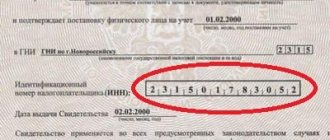The activities of any commercial organization are aimed at obtaining economic benefits, which can be realized through a variety of legal means and in connection with this, additional costs may arise in the form of postage. Indeed, despite the widespread use of new technologies, many organizations remain supporters of conventional mailing methods, both on the sending and receiving side.
The costs incurred when using postal services have such a feature as reasonableness, and documented evidence. Accounting is carried out on a separate account: 44 or 26. Let's look at how to select an account for postal expenses and their accounting.
Selecting an account when accounting for postage costs
Postal costs cannot be directly attributed to the cost price, so they must be accounted for on a separate account, and the following are important: type of activity and direction of postal expenses: (click to expand)
- marketing research – debit account 26
- in other cases - to the debit of account 44
| Trade | Regardless of whether it is a wholesale or retail company, sales costs are considered distribution costs and are not included in the cost of goods. They are collected at count 44 |
| Production activities | These expenses relate to administrative or general business expenses, are accounted for on account 26 and can be written off to the financial result. Expenses for the sale of finished products are classified as commercial, accounted for on account 44 |
| Non-production companies, except trading (brokerage, dealer companies, etc.) | Information on expenses relates to the main activity, therefore account 26 is used |
| Trade and production activities | Account selection is made independently |
Accounting for postal expenses should be enshrined in the accounting policies and working chart of accounts. Costs that are included in postage must necessarily be related to sales for the purpose of including selling costs.
Reflection of postage expenses in accounting
Depending on which postal expenses should be reflected in the accounting accounts, one or another mechanism is used:
- If stamped envelopes are purchased, they are reflected in the cash documents account, and the following entry is made:
Dt 50.3 Kt 60 (71) - reflects the cost of purchased monetary documents.
Learn about the features of accounting for monetary documents from the material “Accounting for monetary documents through an accountable person (nuances).”
Marked envelopes refer to monetary documents on the basis of the Chart of Accounts, approved by Order of the Ministry of Finance dated October 31, 2000 No. 94n.
As the envelopes are used, their cost is written off to general production expenses or sales expenses, and the posting Dt 26 (44) Kt 50.3 is generated.
If envelopes and stamps are purchased separately, then the following transactions are generated:
- Dt 50.3 Kt 60 (71) - reflects the cost of stamps;
- Dt 10 Kt 60 (71) - reflects the cost of envelopes.
From 2022, companies are required to account for inventories according to new rules. The federal accounting standard FSBU 5/2019 “Inventories” has been approved. PBU 5/01 and Methodological recommendations for accounting of inventories and special tools have been cancelled.
Some accounting rules have been changed significantly. The Guide from ConsultantPlus will help you adapt to the new order of inventory accounting. If you do not already have access to this legal system, trial access is available for free.
When the envelopes and stamps are used, the accountant will prepare the appropriate correspondence:
- Dt 26 (44) Kt 50.3 - the cost of used stamps is written off;
- Dt 26 (44) Kt 10 - the cost of envelopes has been written off.
- If postage costs are associated with payment for any service, these costs are immediately charged to general production or selling expenses. This creates the following wiring:
Dt 26 (44) Kt 60 (71).
Find out how an online store can take into account the costs of delivering goods to customers by mail in ConsultantPlus. To do everything right, get a free trial demo access to the K+ system and proceed to the material.
For other aspects of accounting for settlements with accountable persons, read the material “Accounting for settlements with accountable persons” .
Accounting for renting a box at the post office
The organization has the right to choose when receiving correspondence:
- by postal address
- poste restante
- using the cells of a subscription mailbox
Expenses for the use of a subscription box in accounting are reflected as part of expenses for ordinary activities (administrative expenses associated with production and sales) and they are recognized in the tax period in which they were generated, regardless of the fact of payment when using the accrual method; when using the cash method, the amount for rent is included in expenses upon payment. In most cases, the fee is paid several months in advance, which is counted as a prepayment.
An example of accounting for expenses for a subscription box
Alpha and Omega LLC rents a mailbox on the basis of an agreement and a transfer certificate for 9 months from April 1, 2022 to December 31, 2022. The payment was made in a lump sum in cash by the accountable person in the amount of 10,620 rubles. (including VAT 18% - 1620 rubles). The organization uses the accrual method. The following transactions have been made in the organization:
| Operation | Debit | Credit | Amount, rub. |
| The accountable amount was issued from the cash register | 71 | 50 | 10620 |
| A subscription fee has been paid for using the cell | 60 subaccount “Advances issued” | 71 | 10620 |
| Costs for using the cell are written off monthly | 26 (44) | 60 subaccount “Settlements with suppliers and contractors” | 1000 |
| VAT on the subscription fee is reflected monthly | 19 | 60 subaccount “Settlements with suppliers and contractors” | 180 |
| Acceptance for deduction of VAT on postal services provided | 68 | 19 | 180 |
| Partial prepayment amount credited | 60 subaccount “Settlements with suppliers and contractors” | 60 subaccount “Advances issued” | 1180 |
Accounting and postings
Let us immediately emphasize the main thing once again: according to the rules of FSBU 5/2019, administrative expenses, and therefore, in most cases, postal expenses, cannot be attributed to the cost of production. These amounts are taken into account on the “direct costing” principle. On account 20, as was before, they are not written off from account 26 - this is a gross mistake. The write-off goes directly to account 90.
Postage costs may be directly related to the provision of postal services. Then they are written off directly: Dt 26 (or 44) Kt 71 - through an accountable person, for example, the secretary sent letters. The option Dt 26 (44) Kt 60 is also possible, if there is an appropriate agreement with the post office.
Expenses associated with the purchase of stamps are maintained through the 50/3 account (cash documents). There is a direct indication of this in the current chart of accounts. Envelopes with stamps will be reflected by posting Dt 50/3 Kt 71.
If you purchased unmarked envelopes, stamps separately, the main transactions:
- Dt 10 Kt 71 - envelopes.
- Dt 50/3 Kt 71 - brands.
- Kt 60 in wiring is also possible.
- Next Dt 26 (44) Kt 50/3, 10 - consumption of envelopes and stamps.
An example of how stamped envelopes are reflected in accounting. Often, when purchasing stamps or envelopes at a post office, all actions with letters are performed by its employees, including gluing stamps, sealing envelopes, and sending. Here the provision of services takes place, costs can be immediately recorded in account 26 (44).
Another case: envelopes with stamps, stamps are purchased by the office and then issued for use as needed. Then they must first be capitalized in full, and then issued and expended:
- Dt 71 Kt 51 (50) - issuance against report to the employee’s card or in cash.
- Dt 26(44) - Kt 71 - payment for postal services has been written off.
- Dt 50/3 - Kt 71 - marked envelopes are capitalized.
For subsequent use (issuing stamped envelopes for sending letters):
- Dt 71 - Kt 50/3 - part of the envelopes marked was issued to the employee for reporting;
- Dt 26 (44) - Kt 71 - the cost of issued envelopes with stamps has been written off.
Costs for paying for postal services, posting stamped envelopes, the cost of envelopes issued and used for sending letters are carried out on the basis of the employee's advance report.
When the employee responsible for sending letters (secretary, courier) takes envelopes and sends mail, and then reports, the JSC instead of “issuing cash (debiting from a bank account)” makes a note “issuing cash documents.” The supporting document is a mail receipt. As a rule, the report is accompanied by an inventory of the recipients of the shipment, showing how many envelopes were actually used.
Postal expenses are accounted for as other expenses on the date of approval by the AO.
An example of cost accounting for advertising mailings
Alpha and Omega LLC ordered advertising brochures, paid for them and posted them. Half of the booklets were distributed by direct mail, the other half by mail. Postal services are 11,800 rubles. (including VAT - 1800 rubles) The company's revenue for this month amounted to 500,000 rubles. without VAT.
Postage costs for unaddressed advertising are recognized as regulated. The standard will be:
500,000 rub. * 1% = 5000 rub.
The standard is equal to the costs of non-addressed advertising, which means they are taken into account in full - 5,000 rubles. And the postal service accounting will reflect:
| Operation | Debit | Credit | Amount, rub. |
| Paid postage for mailing | 60 | 51 | 11800 |
| Reflected VAT presented by the post office | 19 | 60 | 1800 |
| The cost of postal services for unaddressed mailing is reflected as a sales expense | 44 | 60 | 5000 |
| Accepted for VAT deduction | 68 | 19 | 900 |
| The cost of postal services for direct mailing is reflected as sales expenses | 44 | 60 | 5000 |
| VAT written off for direct mailings | 91 | 19 | 900 |
Expenses for greeting cards for contractors in 1C: Enterprise Accounting ed. 3.0
Published 12/15/2020 16:15 Author: Administrator It’s always nice to receive small “presents”, even if it’s just a postcard. And, knowing the subtleties of reflecting them in accounting, this will not be a hassle for an accountant. However, there is frequent debate on the question “How to take into account the costs of greeting cards for contractors?” confuses many people. Can such costs be included as expenses? According to some opinions, this is a gratuitous transfer and such expenses cannot be written off. The other party believes that this is the cost of office supplies or postage. Who is right? Let's try to understand this issue and look at how to do it correctly in the 1C program: Enterprise Accounting ed. 3.0.
Indeed, if an organization gives something to its counterparties, this is truly a gratuitous transfer; such expenses cannot be written off. But with regards to ordinary postcards and envelopes, their cost can be taken into account as part of the expenses.
First of all, we note that postcards can be presented in two versions:
Option 1: if the postcard contains the symbols of the organization or its brand name, then the postcard can be considered advertising and the costs of purchasing such postcards should be taken into account as advertising costs - the purchase (production) of souvenirs.
According to paragraph 1 of Art. 3 Federal Law “On Advertising” dated March 13, 2006 No. 38-FZ (as amended on July 31, 2020), “advertising is information disseminated in any way, in any form and using any means, addressed to an indefinite circle of persons and aimed at attracting attention to the object of advertising, the formation or maintenance of interest in it and its promotion on the market.”
Option 2: regular postcards that an organization sends to counterparties as congratulations on any holiday - New Year, March 8, etc., can be taken into account as office costs or postal services - paragraphs. 24 and 25 paragraph 1 art. 264 Tax Code of the Russian Federation. Such postcards cannot be considered advertising, because... it is “targeted” in nature and aimed at a certain circle of people.
PBU 10/99 “Expenses of the organization” recognizes the amount of costs for postcards excluding VAT as part of other expenses of the enterprise. Input VAT of the supplier of postcards and postal services, if the relevant documents are available, is accepted for deduction in full (clause 2 of Article 171, clause 1 of Article 172 of the Tax Code of the Russian Federation). As for organizations on the simplified taxation system, unfortunately, such costs are not included in the closed list of expenses. However, many accountants receive these postcards as allowed advertising expenses, or office and postage expenses. Responsibility for this act in this case falls on the employee.
We do not recommend playing cat and mouse with regulatory authorities.
Let's look at examples of the receipt and write-off of postcards and their reflection in accounting.
Receipt of postcards from the supplier and their write-off in accounting
Petrovskie Zori LLC purchased cards to congratulate contractors on the New Year. Based on the supplier’s document, Postal Pigeon LLC, postcards “Happy New Year!” in the amount of 100 pieces for the amount of 2100 rubles, incl. VAT. On the eve of the holiday, postcards were sent to contractors. The organization’s accounting policy provides for recording postcards in account 10.06 “Other materials” as office supplies.
We will reflect the receipt of postcards from the supplier Postal Pigeon LLC based on primary documents.
Step 1. Go to the “Purchases” section and select “Receipts (acts, invoices)”.
Step 2. In the document journal, click the “Create” button and select “Goods (invoice)”.
This document reflects not only the receipt of goods, but also materials. The item count depends on the item card settings and what type it is assigned to by the user - goods, materials, workwear, etc.
Step 3 . Enter the data of the primary document (number and date), select the counterparty and indicate the agreement. If the acquisition is without an agreement, then the agreement with the same name is entered into the “Agreement” field.
Using the “Add” or “Select” buttons, fill in the tabular part with the names of the items and indicate the quantity and cost of the postcards to be purchased.
At the bottom of the document, enter the supplier invoice details and click “Register”. But you don’t have to press the button, because... When posting a document, if the invoice information is specified, it will be registered automatically.
Please note the meaning of the VAT setting: in our example, “VAT in total” and VAT is not included in the price. To open the setting, click the hyperlink in the document labeled VAT.
Step 4. After filling out the document, submit it using the “Post” button. To view transactions and register entries generated by receipt, click the “Show transactions and other document movements” button.
The “Accounting and Tax Accounting” tab displays the following entries:
1. Received postcards from the supplier have been received.
Dt 10.06 Kt 60.01 for the amount of the cost of postcards excluding VAT - 1750 rubles.
2. Input VAT is taken into account.
Dt 19.03 Kt 60.01 for the amount of supplier VAT - 350 rubles.
And for the amount of VAT an entry was made in the “VAT presented” register.
Step 5. Click on the hyperlink of the generated “Invoice” number. A document “linked” to our base document “Receipt (invoice)” will open.
Step 6. Click the button to view the movement of the document.
The supplier's input VAT has been accepted for deduction.
Dt 68.2 Kt 19.03 – for the amount of supplier VAT on purchased postcards – 350 rubles.
The receipt of postcards is reflected in the accounting.
Step 7. Generate the “Account balance sheet” report by selecting account 10.06 “Other materials”.
Let’s make sure that our “Happy New Year” cards are received in the amount of 100 pieces at a cost excluding VAT - 17.50 per piece, for a total amount of 1,750 rubles.
Since we have determined that the postcards are nothing more than stationery, they are written off as usual, using the “Demand-invoice” document.
The “Demand-invoice” document can be generated in several ways:
Option 1: From the receipt document by clicking the “Create based on” button and selecting the “Request-invoice” document. In this case, all names from the source document will be transferred to the new document being created. This will make it easier to enter when there is a large volume of items and eliminate the possibility of errors when selecting items (especially if there are duplicates in the program).
Option 2: from the “Warehouse” section, creating a new document “Requirement-invoice”.
Let's continue the example with the second option for creating the “Request-invoice” document.
Step 8. Go to the journal and click the “Create” button.
Step 9. On the “Materials” tab, select the item to be written off – “Happy New Year!” Postcard. and indicate the quantity.
If the “Cost accounts” checkbox is not checked in the “Materials” list, then the document has a second tab – “Accounts”.
Step 10. Go to the account tab and indicate the expense account when writing off our postcards and the cost item. In our example, the accounting policy provides for the recording of costs in account 26 “General business expenses”.
But you may also use another account, for example, 44.01 “Distribution costs in organizations” or 44.02 “Business expenses in organizations.”
Step 11. Post the document and look at the transactions generated by the “Request-invoice” - button.
The cost of postcards excluding VAT was expensed: Dt 26 Kt 10.06
Envelopes are reflected in accounting in the same way if a postcard is sent to a counterparty in an envelope.
The question arises: “What if the purchased postcards are without a stamp? And did the organization incur additional costs for sending these postcards?” The employee goes to the post office, sends them through the postal service operator, thereby creating postal services.
Let's consider how these expenses are reflected in accounting.
Sending postcards by an accountable person
If services are paid for through an employee of the organization, and he is given funds for this, then an “Advance report” document is drawn up.
We will not dwell on this document in detail within the framework of this article. The procedure for filling it out can be found in our most popular publication “Advance report - how to fill it out in 1C: Enterprise Accounting 8”.
Let's pay attention only to the tabular part reflecting postage costs.
Let's say Employee Lagunova E.I. dealt with the issue of sending postcards to contractors. She was given the amount of 1000 rubles from the cash register for postage expenses. Postage expenses are confirmed by a cash receipt from Russian Post OJSC, about which an advance report has been drawn up.
Let's look at reflecting postage costs step by step.
Step 1. Go to the “cash and bank” section - “Advance reports”.
Step 2. Click the “Create” button and select the “Advance Report” document.
Step 3. On the “Advances” tab, indicate the document for issuing funds to the employee.
Step 4. Go to the “Other” tab and use the “Add” button to enter data from the expense document:
• type of document – “Cash receipt”, its number and date;
• nomenclature – “Postal Services”, indicating in the card the type of nomenclature “Services”;
• amount and supplier.
There is no need to check the SF and BSO checkboxes. The SF mark is established if the supplier has presented an invoice to the organization indicating its number and date. In this case, during execution, the program will automatically generate an “Invoice” document.
Despite the fact that in the receipt from Russian Post VAT is highlighted as a separate line, it cannot be taken into account. We wrote in more detail about the reasons for this phenomenon earlier.
Pay attention to the line at the bottom of the document - it has a continuation, which means that the tabular part is not legal.
Step 5. Scroll the “ruler” and fill in the fields:
• “Cost account” - in our example, account 26 “Overall production costs”;
• Subconto of the cost account – “Other costs.
Step 6. Post the document and generate a document movement report – button.
The cost of postal services is reflected in the organization's expenses:
Dt 26 Kt 71.01 – cost of services excluding VAT, 833.33 rubles.
Incoming VAT reflected:
Dt 19.04 Kt 71.01 – VAT amount 166.67 rubles.
Input VAT is charged to the organization's expenses:
Dt 91.02 Kt 19.04 – VAT amount 166.67 rubles.
For reference, the debit of the tax account NE01.09 reflects the amount of VAT.
This is how expenses for greeting cards for contractors are reflected in accounting. Do not forget that not only postcards are reflected, but also envelopes, stamps and postal services for sending these postcards.
Author of the article: Olga Kruglova
Did you like the article? Subscribe to the newsletter for new materials
Add a comment
JComments
Accounting for postage expenses for payment of dividends
JSCs can use postal orders to transfer dividends to shareholders. Such expenses do not relate to expenses that reduce the tax base for income tax; they are not activities aimed at generating income, because they are paid out of net profit, which means that postage costs must be covered from net profit.
Costs associated with informing shareholders are included in non-operating expenses when calculating income tax. In terms of accepting the costs of reducing the tax base, the situation is similar to that with the payment of dividends by mail.
Strict reporting forms can also serve as confirmation of an organization's expenses for postal services when paying in cash, along with cash receipts.
Advisor to the State Civil Service of the Russian Federation, II class Ya.Ya. Chometz
Documentary registration of postage stamps
Quote:What should be the report for postage stamps issued at the cash desk of an enterprise (office) for sending correspondence? Is it necessary to prepare an advance report for stamps purchased by an enterprise by bank transfer? The question is answered by V.A. Bikbaeva, an expert of the magazine. First of all, let us remind you that, according to clause 1 of Art. 9 of the Federal Law of November 21, 1996 No. 129-FZ “On Accounting” (hereinafter referred to as Law No. 129-FZ), all business transactions carried out by the organization must be documented with supporting documents. They serve as primary accounting documents on the basis of which accounting is conducted. Postage stamps belong to the category of monetary documents. The accountant should write off the cost of such documents only after confirming the fact of their use. Cash documents are stored at the organization's cash desk, therefore, their receipt and disposal are formalized by issuing receipts (form No. KO-1) and expenses (form No. KO-2) cash orders. The cashier is responsible for the movement and safety of documents, with whom an agreement on full financial responsibility is concluded. As a result of the satisfaction of the written application of an employee with a manager’s visa to provide him with postage stamps for sending correspondence, responsibility for these material assets is now borne by this employee - the accountable person. To confirm the use of postage stamps, it must prepare an advance report in form No. AO-1, which is contained in the Album of unified forms of primary accounting documentation, approved. Resolution of the State Statistics Committee of Russia dated August 1, 2001 No. 55. If postage stamps are used when sending correspondence by registered mail, employees attach the corresponding receipts received at the post office that accepted these letters according to the postal list to the advance report. Please note that the advance report indicates the receipt number, which is located next to the date of issue of this document. The postal list remains with the accountable person (in the preschool educational institution service) and may not be submitted to the accounting department; the numbers of postal items are reflected in the receipt (in the case of a large number of items, the numbers of the first and last of them in the list are recorded). In the case when correspondence is sent by simple letter, a report on the consumption of postage stamps can serve as a document confirming the use of postage stamps. There is no prescribed form for such a report. It is drawn up and signed first by the person responsible for the brands, then by his immediate supervisor, and approved by the head of the organization. Please note: This document includes all stamps received, used and remaining at the end of the month (both those affixed to registered items for which you have postage receipts and those sent as regular letters). What we colloquially call “postage stamps” has an official name – “postage stamps”. It is under this longer name that they should appear in all documents drawn up. Next, the advance report verified by the accounting department with attached supporting documents (receipts and/or a report on the consumption of postage stamps and envelopes) must be approved by the head of the organization or an authorized person, for which the corresponding details are provided at the top of the front side of the advance report form. After approval, the document is accepted for accounting to write off used stamps from the accountable person. The remainder of unspent stamps goes to the cash register. Based on the above, let us formulate a clear answer to the question asked. In any case, you will have to prepare an advance report on the consumption of stamps received in your accounting department. The only difference is what supporting documents you attach to it (receipts received at the post office, or a personally compiled report on the use of stamps). In addition, another situation is common when a preschool service employee is given not stamps (previously purchased in bulk), but cash to pay for postal services. In this case, the accountable person will also have to draw up an advance report and report on the expenditure of the money received, so that these accountable amounts “hanging on him” will be “withdrawn” from him. It should be noted that the frequency of preparation of the advance report is approved by the accounting policy of the organization. In the example under consideration, we proceeded from the fact that, according to the accounting policy, the accountable person is obliged to prepare an advance report once a month.
Accounting for postal expenses for individual entrepreneurs
The expenses of an individual entrepreneur can be presented as, for example, sending 3-NDFL by mail. When calculating personal income tax, an individual entrepreneur has the right to professional deductions based on documented expenses, moreover, carried out to generate income. Thus, postage expenses may be the basis for a professional deduction when calculating personal income tax.
Prepayment for the use of a mailbox is taken into account in the same way as other advances issued
Important! An individual entrepreneur independently determines expenses for activities aimed at making a profit in the same way as organizations in accordance with Chapter. 25 Tax Code of the Russian Federation.
Answers to common questions
Question No. 1: Can the delivery of documents from the counterparty via a freight forwarding company be attributed to postal expenses and on what account should they be accounted for? (click to expand)
Answer : The organization has the right to attribute these expenses to postal expenses and reflect them on account 44 because it has to do with implementation.
Question #2 : How are stamps counted for any form of mail?
Answer : In accounting, the cost of purchased stamps is taken into account as part of administrative expenses (account 26 or account 44) only after they are used for dispatch. Stamps must be accounted for as an independent asset if they were purchased using a separate invoice and, before being written off as expenses, are reflected in account 50 of the “Cash Documents” subaccount. When affixing stamps by mail, the sender pays for the postal service and reflects the postage costs in full (according to invoice 26 or 44).
What are these expenses?
With the help of mail, the company solves many issues. The sales department, for example, sends out advertising materials to potential buyers, the HR department sends various notifications to employees, the accounting department sends reconciliation reports and completed work, invoices to contractors and tax reporting.
Thus, postage costs, including costs for postage stamps, are costs incurred by an organization in carrying out its production and economic activities.
Since they are not directly related to the production process, they are classified as administrative expenses.







